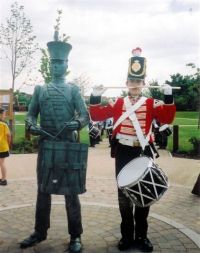|
The Sad Tale of Drummer William Lane
This story
by Dawn Kirkwood appeared in the Thurmaston Times |
|||
|
William Lane was baptised at the parish church of Waltham On The Wolds on 30th August 1797; the eldest of seven known children of John and Hannah Lane. On 23rd May 1813, aged 15, William enlisted as a boy recruit in the 39th Regiment of Foot (Dorset), and joined the battalion in Weymouth. He was promoted to Drummer on 24th July 1815 and, in April the following year, joined the 1st battalion in France where they formed part of the Army of Occupation after the end of the Napoleonic Wars. In December 1818 the regiment was posted to Ireland where, as well as attempting to keep the peace, they provided protection for the excise men as they tracked down illicit stills. William finally returned to England in September 1821 on recruitment duty and was stationed in Leicester, where he met and married Mary Warren at St Margaret’s Church on 13th July 1822. On the fateful day of Monday 28th November 1822, William Lane had been recruiting at the Twyford Statutes and, leaving his comrades in Syston, was on his way back to his wife in Leicester who had recently given birth to a son. With his drum slung across his back, William reached Thurmaston village where he met three local young men outside the home of John Bishop Allen. He stopped to talk to them and one of the lads began to tap on his drum, whereupon Allen appeared at an upstairs window with a gun in his hand and said “You chaps be off or else I’ll fire”. William replied, saying ‘I am on my march, on His Majesty’s duty, and I hope you won’t shoot me; I hope you are only joking.” Unfortunately unknown to William, Allen had been tormented and kept awake over several nights by the three lads, and was in no mood for joking; he raised his gun and fired, severely wounding William in the lower part of his stomach. After another brief exchange of words, he fired a second shot, this time wounding William in his arm. William was taken across the road to a public house called The Plough, and a surgeon, Mr. Birdsall, (who lived at Syston) was sent for. However, William died from his wounds three days later, the day after his son, also called William, was baptised. John Bishop Allen was arrested and committed to the County Gaol in Highcross Street, Leicester. He was tried at Leicester Assizes on Friday April 11th, 1823, where he was found “Guilty of murder, being in a state of insanity at the time of committing it” and was sent back to gaol to await sentencing. He died on 15th October 1827 and was buried at Thurmaston. Friends of John Bishop Allen erected a gravestone (which can be seen on the left just as you enter through the gates of St. Michael’s Church) to the memory of the unfortunate soldier which bears the inscription: William Lane
|

